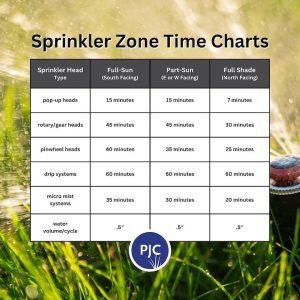Organic Turf Care Simplified
As we transition out of July heat and into prime turf growing season, follow these late-summer organic turf tips. We want to make sure that you are checking all of your boxes for growing lush green grass – ORGANICALLY!
1. Irrigation Audit
 If you are watering, test and check all of your irrigation heads. Ensure you are maximizing coverage on your lawns and fields, and take into account natural rainfall. Water is a precious resource. Accordingly, watering efficiently will help give your established turf and germinating seedlings the best chance to take root and push vigorous shoots. Check out our 1-2-3-2-1 Method.
If you are watering, test and check all of your irrigation heads. Ensure you are maximizing coverage on your lawns and fields, and take into account natural rainfall. Water is a precious resource. Accordingly, watering efficiently will help give your established turf and germinating seedlings the best chance to take root and push vigorous shoots. Check out our 1-2-3-2-1 Method.
2. Repair and Level Trouble Areas
Before you get back into the routine maintenance schedule, take time to repair trouble spots. PJC Organic recommends a 60/40 loam compost mixed with seed for repairs. Whether it’s a goal mouth or an area holding water in a client’s backyard, premix seed with your top dress blend and give a little TLC to those trouble spots. Consistency is key with trouble areas, which is why it’s recommended each season. Be sure to stick with it and the results will speak volumes to your customers. Use a 2”x4” board or a leveling rake to blend with surrounding areas.
3. Sharpen Mower Blades and Clean Mower Decks
After 25 hours of use, be sure to sharpen your mower blades! This prevents damage to grass blades. If you notice your grass has white tips, it’s an indication that your dull mower blades may be tearing the grass. In addition, remember to keep grass height at 3″ minimum to crowd out weeds and return clippings. Clean equipment reduces the spread of disease. Keep in mind that this rainy and humid summer has been especially difficult for fungal pressure. Therefore, keep your mower decks clean between sites and do a daily detail at the end of the day.
4. Soil Test
Every 3 years perform a soil test. For accurate results, be sure to test at least 6 weeks after your last fertilizer application and before any late summer product apps. Run your tests through us to make your product recommendations easy and keep your focus on turf.
5. Core Aerate
You can start aerating as soon as August 1st on irrigated lawns, or as early as August 15th on non-irrigated ones. Core aeration is one of the best methods of alleviating soil compaction there is! In addition, be sure to use hollow tines, because solid tines only perpetuate compaction problems.
6. Overseed
A big aspect of our late-summer organic turf tips includes prepping to over seed. Accordingly, take advantage of those aeration holes and introduce a new crop of turf. Late-summer over seeding provides the best window for seedling germination and establishment—giving you a more diverse and resilient turf stand year after year. Grass seed is our primary method of weed control! View our Grass Seed For Fall Blog for seed blend information and recommendations.
7. Charge the Soil!
Apply PJC ProHealthy Turf CHARGE-S3 to prime your soil and turf for fall. Applying directly after aerating puts precious nutrients directly into the root zone. Thus priming the microbes for a long-term feed coming out of summer.
8. Feed the Turf!
Apply PJC ProHealthy Turf Organic Fertilizers within a few weeks of Charge S3 for best results (or simultaneously if you need to be efficient). This will provide balanced nutrition for soil microorganisms and your soon-to-be flourishing turf. We provide a wide range of fertilizers to make sure you achieve your annual fertility needs.
9. Apply Calcium
An oft forgotten but essential macro nutrient. Calcium is integral to healthy turf plants and nutrient dense soils. Whether you are looking to increase a low pH, alleviate compaction chemically, chelate essential metal ions for plant uptake, or increase cation exchange capacity—we have the product set for you! Use High Efficiency Lime, Gypsum or Boost+S3 respectively to achieve different calcium needs for your soil. Be sure to apply these before the ground freezes. October 15th is usually a safe closing window, so this can be done with either late summer or fall applications!
10. Scout and Treat Grubs
Start scouting mid August – mid September. First, cut three sides of a square turf section, about one square foot in size. Then, hold back the turf and examine the roots about 3 – 4” deep. Count the number of white grubs. Do this in at least 3 – 4 different spots around the lawn (typically sunny locations). A healthy stand of turf can withstand grub damage. However, if you find 7 or more per SF then treat with Cedar Oil. Furthermore, remember you don’t need to treat the whole lawn. Only treat the border areas where you have found evidence of grubs, generally < 1,000 SF. Read more on PJC’s blog “Treat Grubs Organically”.
Don’t skip a beat these next few weeks and set yourself up for your best growing season yet. Follow these late-summer organic turf tips and transition out of summer well to set up for a successful fall.








